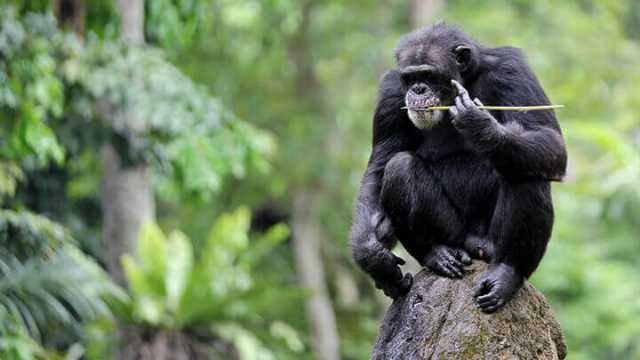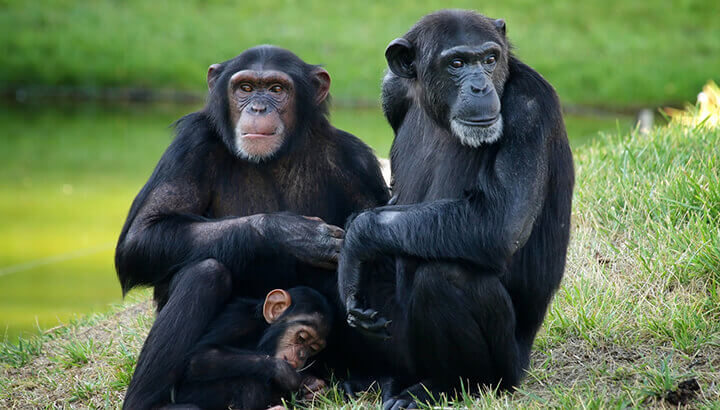
Researchers from the Comoé Chimpanzee Conservation Project have used hidden cameras to capture never-before-seen tool use amongst a population of chimpanzees. This is just one of the many amazing reasons we need to save chimps — and fast.
Chimpanzees use ‘drinking sticks’
Located on the Ivory Coast, a rather clever troop of chimpanzees has learned to develop long “drinking sticks.” This allows them to collect water from deep sources that would otherwise be unavailable to them. This method of collecting water provides the chimpanzees with a competitive advantage over less adept species in their dry region.
The chimps will chew on the sticks to soften them up, creating an absorbent tool. They then dip them into the holes of trees where hard-to-reach water is stored. Similarly, chimpanzees have been known to use large sticks to collect termites or collect honey from bees’ nests. This is the first time researchers have discovered chimps using tools for drinking, however.
Chimps pass down knowledge to their young
Chimpanzees pass knowledge down from generation to generation by demonstrating behavior to their young. This means each new generation builds upon learned skills of those that came before them. Each generation has more tools, skills and knowledge to build on, creating an ever-developing society and culture of their own.
It would be fascinating for scientists and wildlife enthusiasts to see just how far this and other troops of chimpanzees can come. Unfortunately, chimpanzees are listed as an endangered species. If efforts aren’t taken to conserve their habitat and population, we will never know how intelligent and skilled they could become.
Chimpanzees use spears to hunt
In 2007, researchers published a study in which they found chimpanzees using spears for hunting. This wasn’t just finding and using large sticks, mind you. The chimps were chewing them in such a way to create a sharply pointed edge designed for prey.
Researchers made the observations on a troop of chimps in Senegal as they hunted for small mammals named galagos. Researchers also noted that while adult males in the troop did the majority of the hunting, the spear use was more common amongst adolescent females and males.
The team hypothesized that when new technology is introduced into chimpanzee society, the younger generation is more prone to its use than older ones. Sound familiar? The researchers failed to comment on if any of the older chimpanzees complained the younger generation was spoiled with their fancy spears and tools. Back in their day, they had to use their hands to hunt, not like these lazy chimps today!
Chimpanzee populations are endangered
Like most endangered animals, chimpanzees are threatened by loss of habitat. In the Ivory Coast, where the stick-drinking troop were found, poachers hunt them as bushmeat. According to the World Wildlife Fund, chimpanzee habitat in the country has declined 90 percent over the last 20 years.
Additionally, chimpanzees are also victims of the illegal wildlife trade. Sadly, it is often babies that are taken from the wild and sold as pets. They also are a frequent victim of “sham sanctuaries.” These tourist attractions often convey to the public that the animals were orphaned in the wild or that they were in need of medical attention. However, this is often just an attempt to alleviate any guilt a tourist might feel before buying a ticket to the attraction.
The sole survivor of a chimp colony
Sadly, one troop of chimpanzees is now down to its final member. This was not a troop which developed organically in nature. And it wasn’t habitat loss, disease or hunting which caused the loss of these chimpanzees — but it was human action all the same.
The chimp goes by the name Ponso to his human friends. He is the lone survivor of a troop of 20 who were dumped on the island 30 years ago. Ponso and the others were left on the island by the New York Blood Center in the 1980s after being used in medical research on hepatitis.
Assumedly, the Blood Center felt the chimps would be able to survive on the island, but only Ponso has. Many succumbed to starvation years ago. Experts believe Ponso’s final chimpanzee friend died in 2013.
A local farmer named Germain comes by to visit Ponso, as well as to give him bread and bananas. Ponso is now in his 40s. The average chimpanzee lifespan is between 40 and 50 years.
Can ecotourism save the chimpanzees?
Chimpanzees are normally reclusive, which makes it hard to develop an ecotourism program in their habitat. One of the most important aspects of ecotourism is that tourists should leave as little impact on the environment as possible. Invading an animal’s habitat is normally off-limits.
The Ivory Coast’s Tai Park is a unique case, however. Film crews with Disneynature spent four years filming “Chimpanzee” in the park. As a result, many of the chimpanzees have habituated to humans.
In 2014, two years after the release of Disney’s film, the park launched an ecotourism program in the hopes of protecting chimpanzee habitat. If sustainability-minded tourists are able to bring their dollars to the region, it could help encourage local governments to stop the further encroachment on chimpanzee habitat.
Touring with the Wild Chimpanzee Foundation
Christophe Boetsch of the Wild Chimpanzee Foundation is hopeful that the program can evolve in a way that is beneficial for both local residents and chimpanzees. “Through ecotourism, local people gain something. They see the value of the forest, and they will preserve it,” Boetsch stated shortly after the program’s launch. “The more tourists we have, the more likely we will be able to win the battle.”
The Alternative Daily reached out to the Wild Chimpanzee Foundation. They let us know that anyone interested in arranging an ecotourism trip to the area can contact Monik Philippe with Ivoire Voyage Tourisme. Interested parties can call (+225) 22-43-15-61, (+225) 22-43-60-28 or (+225) 05-05-04-02.
How to help chimpanzees

Chimpanzee population decline can be a difficult problem to assess, considering that most populations are reclusive and difficult to study. The Western chimpanzee population is estimated to be between 21,000 and 55,000 individuals. It is difficult to determine how quickly that population is decreasing.
Non-governmental organizations are working to develop ecotourism programs in chimpanzee habitat which can hopefully provide financial incentive to decrease deforestation. In addition, programs are working with local governments to stress the importance of national parks and protected areas. But without the support of concerned people from all over the world, we run the risk of losing the chimps forever. Should that happen, we will never get to know just how developed their cultures can become.
You can help support the Wild Chimpanzee Foundation’s work in Tai Park and elsewhere by making a donation through this link. The World Wildlife Fund is also on the ground, working with local governments and tour operators to help put an end to the deforestation that threatens the chimpanzees. You can support their work by making a donation. Or, you can symbolically adopt a chimpanzee through this link. It makes a great gift for any wildlife lovers you might know!
— Ian Carey

